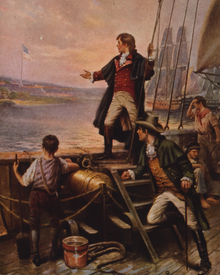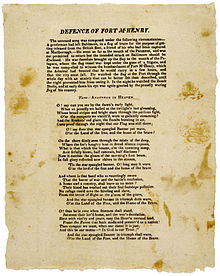The Star-Spangled Banner
The Star-Spangled Banner has been the official national anthem of the United States since March 3, 1931 . The text was written by Francis Scott Key in 1814 . He wanted to express his joy at America's victory over the British, who had heavily bombed Fort McHenry near Baltimore with their warships that night during the war of 1812 . The reason he paid tribute to the United States flag (the "Stars and Stripes") was because of his relief that it was still flying over the fort the day after the British attacks.
The melody comes from the popular English drinking song To Anacreon in Heaven by John Stafford Smith . In 1916 the American military bands received instructions from President Woodrow Wilson to play this song on official occasions. It was not until 1931 that the binding melody for the hymn was officially set in addition to the text.
text
On official occasions, only the first verse of the Star-Spangled Banner is usually sung. The third and fourth stanzas do not count towards the national anthem because of their strongly anti-British tendencies .
original
|
1. O! say can you see |
2. On the shore dimly seen |
3. And where is that band |
4. O! thus be it ever, |
translation |
|||
|
1. O say, can you see |
2. Can still be seen on the bank |
3. And where is the group |
4. Oh, so be it forever |
History of origin

On September 3, 1814, during the British-American War , Francis Scott Key and John Stuart Skinner were on the HMS Minden to obtain the release of a friend, William Beanes . He was captured in Washington, DC on charges of helping to capture British soldiers. Key and Skinner boarded HMS Tonnant on Sept. 7 and spoke to General Robert Ross and Admiral Alexander Cochrane over dinner as they discussed war plans. Initially, Ross and Cochrane refused to release the captured Beanes. They soon gave in, however, when Key and Skinner showed them letters from wounded British prisoners thanking Beanes and other Americans for their treatment.
Since Key and Skinner learned of plans to attack Baltimore , they were held until the end of the battle; first on board the HMS Surprise, then on the HMS Minden, on which they waited behind the ranks of the British fleet for the end of the battle. The attack began on September 13 and the bombardment of the city lasted 25 hours. At the end of the battle the following morning, Key was inspired by the American victory; especially the image of the American flag still hoisted amidst the evidence of the battle.
The next day Key wrote a poem on board the ship on the back of a letter that he still had in his pocket. After arriving in Baltimore with Skinner, he finished the poem he called Defense of Fort McHenry at the Indian Queen Hotel. Key later gave his poem to his brother-in-law Joseph Nicholson, who noted that it matched the tune of To Anacreon in Heaven . Nicholson had the poem printed anonymously on September 17; three days later it appeared in the Baltimore Patriot and The American with the comment Tune: Anacreon in Heaven . A little later, Thomas Carr published text and melody together under the name The Star-Spangled Banner , under which it quickly became known.
Spanish and other non-English versions
During the Civil War , a modification of the song called The Flag of Secession was sung to the same melody in the Confederate States of America .
In the course of the discussion on the legal status of immigrants, a Spanish version with Latin rhythms was recorded in 2006 under the title Nuestro Himno (Our Hymn). However, it is by no means the first foreign-language version of the US national anthem (and also not intended as such), nor is it the first Spanish version. This was published by the US Department of Education in 1909. The new version of Nuestro Himno was recorded by artists such as Gloria Trevi , Carlos Ponce and Olga Tañón and released on April 28, 2006. The Spanish version of the anthem is seen as an answer to the discussion about tightening US immigration laws. Conservative circles are demanding the massive deportation of illegal immigrants. Nuestro Himno is representative of the Latino immigrants, who are estimated to include over ten million illegal immigrants. Contrary to the ideas of those involved in the production, the piece is not only seen as an expression of the feeling of belonging to the United States of America, but also partly as a denigration of the national anthem and a rejection of the value system of American society.
In 1851, a German translation of the English text by Hermann Seele, who was born in Hildesheim in 1823 and emigrated to America in 1843, was published. He probably wrote the version for the Texas Singing Association , but the version quickly spread among German-Americans in the United States.
|
1. O! Say, can you see |
2. To see |
3. And where is the bond that |
4. And where the men
stand united for |
Walter D. Kamphoefner , historian and migration researcher at A&M University in Texas, found in his studies that this German version was sung in Illinois schools in 1917, which were mostly attended by German-speaking students. With the entry of the USA into the First World War , this stopped suddenly.
More performances
- The German composer Hugo Kaun composed a symphonic festival march for large orchestra (op. 29) on this melody.
- Jimi Hendrix performed a sensational performance at the Woodstock Festival in 1969 . In protest against the Vietnam War, he let the melody of the anthem drown in the war noise made on the guitar.
- Whitney Houston sang a soul version of Super Bowl XXV in 1991, which was released as a single and landed at number 20 in 1991 and number 6 in 2001, the second time after José Feliciano's version that the anthem was on the Billboard Hot 100 was.
- In 2006 the Slovenian band Laibach, originally from the post-industrial environment, released a cover version under the title America on the album Volk , on which they reenacted national anthems.
- The Canadian band Daylight for Deadeyes released a cover version on February 26, 2013.
Rules of conduct
Title 36 of the United States Code , Section 301 regulates the expected posture when playing the national anthem:
- Conduct during playing
- During a rendition of the national anthem -
-
(1) when the flag is displayed -
- (A) all present except those in uniform should stand at attention facing the flag with the right hand over the heart;
- (B) men not in uniform should remove their headdress with their right hand and hold the headdress at the left shoulder, the hand being over the heart; other
- (C) individuals in uniform should give the military salute at the first note of the anthem and maintain that position until the last note; other
- (2) When the flag is not displayed, all present should face toward the music and act in the same manner they would if the flag were displayed.
Translation:
- Conduct during the performance of the national anthem
- 1) When the flag is up,
- a) All those present, with the exception of those in uniform, should turn to the flag and place their right hand on their heart;
- b) Men who are not in uniform should remove their headgear with their right hand and hold it on their left shoulder so that their hand is over their heart;
- c) uniformed persons should salute from the first to the last note of the hymn.
- 2) If no flag is hoisted, all those present should turn in the direction of the music and behave as if the flag was being displayed.
literature
- Irvin Molotsky: The flag, the poet, and the song. The story of the Star-Spangled Banner . Dutton, New York 2001, ISBN 0-525-94600-4 .
Web links
- The US national anthem on music.army.mil
- The Star-Spangled Banner : Sheet Music and Audio Files in the International Music Score Library Project
Individual evidence
- ^ Francis Scott Key: The Star Spangled Banner (lyrics), 1814
- ^ The flag of secession in the English-language Wikisource
- ↑ loc. Gov
- ↑ Text and audio at washingtonpost.com
- ↑ memory.loc.gov
- ↑ Jimi Hendrix: "Star-Spangled Banner" . In: Martin Geck : War and Peace. Materials for music lessons . Marohl Musikverlag, Witten and Stuttgart 1984, ISBN 3-89006-022-6 , p. 41.
- ↑ Daylight For Deadeyes: The Star Spangled Banner - Daylight for Deadeyes. February 26, 2013, accessed July 11, 2019 .




